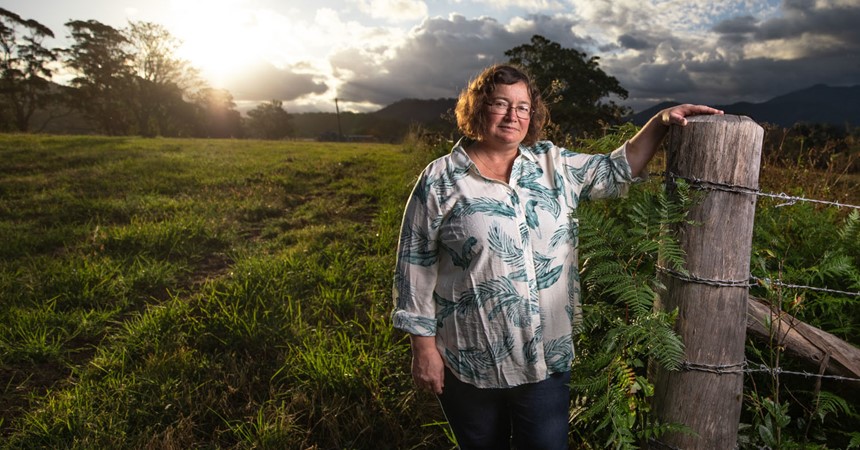Mark Mowbray, former principal of St Joseph’s Primary in Taree, bought a block at Rainbow Flat, halfway between Forster and Taree, 25 years ago. He describes last summer’s fires surrounding his property as the most terrifying day of his life.
Sue Abdoo enjoyed a “no dramas” rustic lifestyle for 23 years on her holding at Killabakh, north of Taree also in the mid-north coast hinterland. But in three months over the past summer she endured a lifetime’s worth of disaster. Bushfires not once, but twice, swept through her property, leaving her on the ropes but still standing. She then copped the worst of a once-in-generation storm.
“I lost a lot of fences in the fires,” she says, “but thanks to the Rural Fire Service aerial assaults I was spared losing everything.” But not long after, other water from the sky in the form of a storm came in for the knockout blow, damaging buildings that had been saved from the fires.
“The fires certainly caused a lot of angst, but people are showing signs of being more relaxed,” Ms Abdoo says. “Killabakh was only one of many areas affected, obviously, and we lost eight houses. But there has been a lot of material relief in the form of food parcels, fencing material and manpower. BlazeAid has been really helpful to many of the locals.”
There’s a delicious irony in that statement. Ms Abdoo has been tireless in her commitment to CatholicCare’s Taree Community Kitchen, which serves free meals five days a week to the marginalised and offers them a space where they can feel safe and enjoy the company of others.
Bushfire victims received assistance from Manning Valley Neighbourhood Services’ bushfire emergency relief support. In terms of mental recovery Ms Abdoo says, “there is still anxiety, but it’s getting better”.
“Even after the bushfire threat had passed, any helicopter noise created instant panic,” she says. “We were all living on the edge during that time, constantly looking out for puffs of smoke. And we’ve had floods since the fires. Still, we would rather water lapping around us than flames any day.”
One of her neighbours gave her the heads-up recently of a planned burn-off. He told me to “expect some friendly smoke” Ms Abdoo says. “People are starting to burn off rubbish again. By and large there’s lots of normality coming back.
“One of the Killabakh houses burnt down in the November fire is already laying down a slab for the replacement. All the due process has been carried out in a fairly timely manner as far as I can see. It’s not the bushfire relief causing concern for me, it’s the insurance claim for the storm damage. The buildings have been exposed for three months now, which is a worry.”
South-east of Ms Abdoo at Forster Tuncurry, parish priest Greg Barker is more concerned at just what has happened to bushfire relief money. “I think there was about $44 million raised and it would be good know how it has been distributed,” he says.
The St Vincent De Paul Society has been active in Fr Barker’s parish helping those affected by the fires. “But where has the rebuild money gone?” he asks. “People were promised financial support. Has the coronavirus scuttled it?”
Hobby farmers and other small producers, it seems, slip through the recovery cracks because off-farm income can affect their access to fire aid. If less then 50 per cent of income is derived from their farms they are not covered by any funding or grants.
Mr Mowbray is proud of his 30 years as a principal and his 25 years building a rural holding “up from nothing”.
“Before the fire hit last November, we had been in the midst of our worst drought on record,” he says. “We were feeding our breeding stock twice a day, a costly and stressful exercise. Our farm was dead. All the cattle had to eat was what we gave them.”
When the fires hit, Mr Mowbray’s property was surrounded within half an hour. “We had no choice but to stay and fight alongside the amazing RFS volunteers who had left their homes in western NSW to come and help out in the worst fires on record for our district. It was the most terrifying day of our lives, but we saved our home and stock.”
With the help of BlazeAid he has replaced more than two kilometres of fencing. “Mostly, these volunteers are young backpackers from all over the world,” he says. “They cheerfully give their time to help out those in trouble. Amazing.”
But six months later he is still waiting for his entire roof and some of his veranda to be replaced — and a much greater worry is the native vegetation and wildlife.
“We saved one koala after the fires and worry how long it will take before the forest repairs and the fauna and flora return to normal,” he says.
“We thank God for the blessings of keeping our home, for the RFS, for the BlazeAid volunteers, for the rain that broke the drought and gave life to many of our trees, and for the immense support we received from community, family and friends.”






















































































